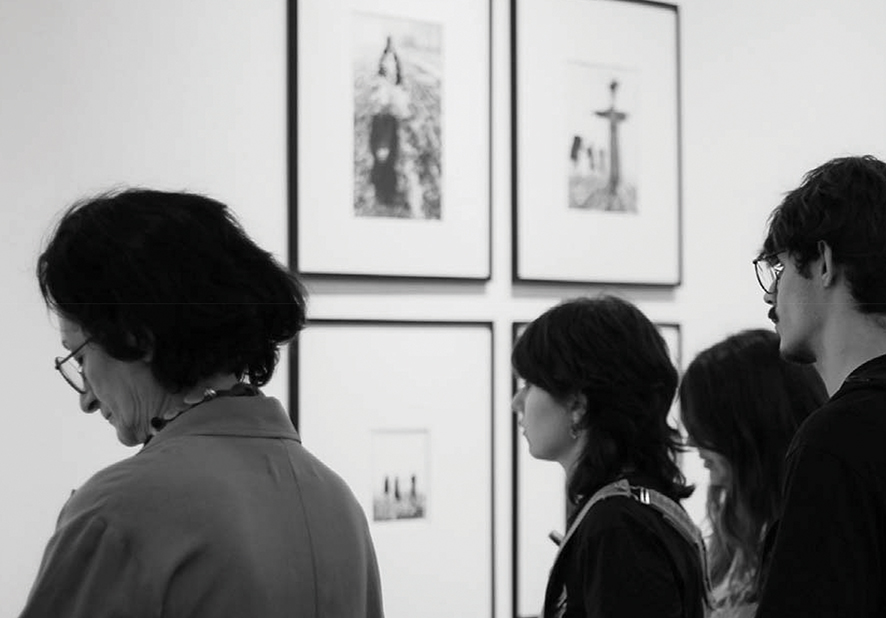Walking into the Zurab Tsereteli Museum of Modern Art, one immediately senses that the exhibition, titled ‘Poets, Masks, Actors, Ghosts’ and curated by Paola Lasalandra with creative direction by Irakli Nassidzé, is a pilgrimage through the phantasmagoric soul of Mario Lasalandra’s oeuvre. The exhibition, which runs until June 12 as a part of KOLGA TBILISI PHOTO 2025, unfolds like a theater, where the photographer’s imaginary Italy, drenched in black-and-white surrealism, stretches its wings. Around 150 vintage prints, each a world within itself, speak not only to the mastery of Lasalandra’s craft, but to his uncanny ability to straddle reality and myth, everyday life and staged fantasy.
The Visual Rituals of a Magical Surrealist
Lasalandra’s art inhabits a space where the mundane is spun into enchantment. The photographer, who candidly admitted his desire to become a filmmaker—a desire thwarted by his unwillingness to sacrifice family for Cinecittà—crafted his imagery with cinematic ambition. His photographs are not mere documents, but ritualistic performances where his native Italy becomes a stage of timeless characters, ghostly poets, and masked apparitions.
Lasalandra’s aesthetic roots intertwine with the Italian cinematic greats—Antonioni, Fellini, Bergman, and Pasolini—whose storytelling defined an epoch. Yet his vision remains unique, marked by a lyrical stillness that contradicts the freneticism of film. His early lessons in light and composition, drawn from the baroque vibrancy of Giambattista Tiepolo and the solemn mysticism of Saint Thecla’s altarpiece, linger in the chiaroscuro that defines his prints.
Ghosts of the Commune: The Enchantment of the Everyday
One of the most striking aspects of Lasalandra’s work is his ability to blend community and fantasy. The exhibition dedicates a portion to Il Magico—a project that began in 2003 in San Felice sul Panaro (Modena), where, for one day, local residents transform into surreal characters, reviving the town’s forgotten myths. Lasalandra’s lens captures this temporary metamorphosis, suspending ordinary people between their daily selves and the enchanted roles they embrace.
It is in these communal rituals that the line between art and life blurs most poignantly. Lasalandra directs these events as one would a film, infusing everyday environments with dreamlike energy. This transformation is not a mere aesthetic decision, but a political one—a resistance to homogenization, a celebration of local identity through collective participation.

Identity Fragmented and Reimagined
The motif of masks recurs throughout the exhibition, symbolizing not only performance but the fluidity of self. In one photograph, an elderly woman stands in a dilapidated square, her face obscured, her posture rigid as if bracing against both time and modernity. Lasalandra’s subjects never merely wear masks—they become them, embodying layers of memory and emotion.
This nuanced portrayal of identity—fragmented, layered, often contradictory—echoes the work of Fellini, particularly his fascination with the carnivalesque and grotesque. In Lasalandra’s universe, the grotesque does not repulse but seduces, inviting the viewer to reflect on the complexity of human experience.

Surrealism Rooted in Reality
The exhibition also confronts the notion of surrealism as escapism. Lasalandra’s images are anchored in the tangible—cracked pavements, rustic facades, hands worn from labor—reminding us that the surreal emerges not from fantasy alone, but from reimagining the familiar. The rural Italian landscape becomes both a backdrop and a protagonist, its rugged beauty amplified through Lasalandra’s alchemical eye.
As viewers move through the gallery, they encounter not just photographs but echoes of stories—half-forgotten local legends, peasant rituals, and a collective yearning to transcend the mundane. In Lasalandra’s hands, photography becomes a form of storytelling where past and present collide, reshaping the ordinary into something eternally poetic.
The Echo of Italian Cinema in Georgian Space
There is a unique resonance in presenting Lasalandra’s work in Tbilisi, a city where folklore and contemporary art coexist in a tenuous yet vibrant dance. Just as Lasalandra’s Venice becomes a locus of myth and reality, Tbilisi’s layered history and eclectic spirit find a kindred echo in his aesthetic. The creative direction of Irakli Nassidzé accentuates this cross-cultural dialogue, weaving Georgian sensibilities into Lasalandra’s distinctly Italian vision.
In a world increasingly dominated by the slickness of digital manipulation, Lasalandra’s tangible, textural photography reminds us of the power of crafted images—ones that do not conceal their imperfections but rather celebrate them. The exhibition’s relevance lies not only in showcasing the past but in inviting contemporary audiences to reconsider how art can root us to place, community, and collective memory.
By embracing masks, ghosts, and poetic fragments, Lasalandra challenges us to confront the paradoxes of our own identities, to embrace the theatricality of daily life, and to seek the magic in the mundane. As we wander through the exhibition, we realize that Lasalandra’s Italy is not so distant from Tbilisi—it too is a city haunted by its past, searching for new forms of expression amidst the ghosts of tradition.
Poets, Masks, Actors, Ghosts is not just an exhibition—it is a call to reimagine the spaces we inhabit and the selves we construct. Lasalandra’s art, suspended between reverie and reality, prompts us to explore how the act of seeing shapes not only how we perceive the world but how we position ourselves within it. As we leave the gallery, Lasalandra’s figures linger in our minds—mysterious, resolute, and defiantly beautiful—reminding us that art, like memory, is a masquerade we must willingly embrace.
By Ivan Nechaev














